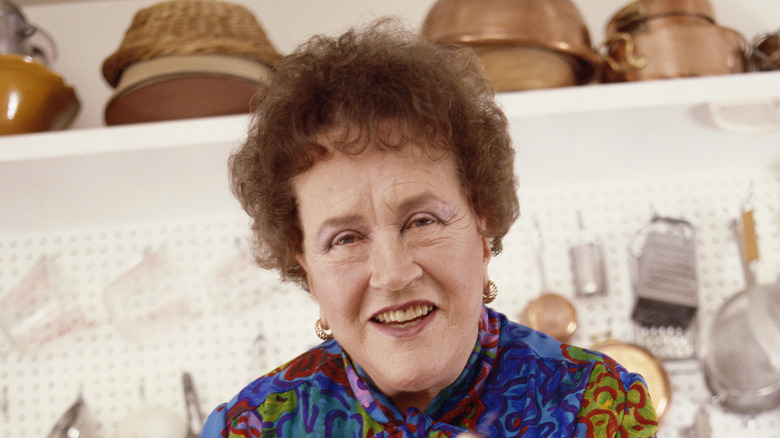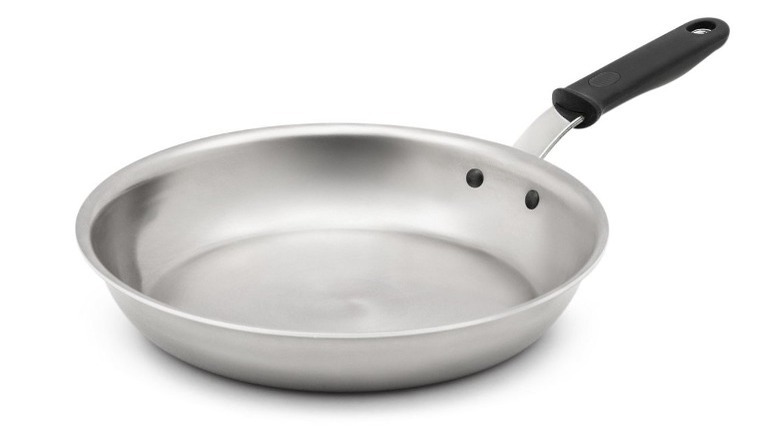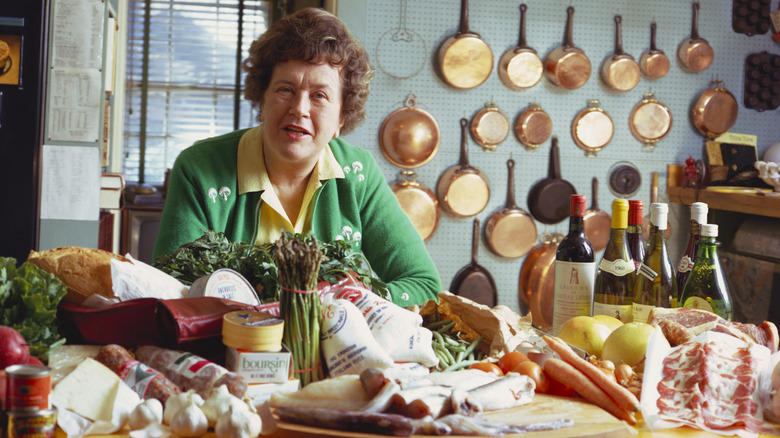Julia Child's Go-To Nonstick Pan Is Both Affordable And Dependable
Through her many cooking programs and engrossing cookbooks, beloved chef and master of French cuisine Julia Child has left a lasting legacy on the culinary world. Even to this day, home cooks and professional chefs alike still draw on her for inspiration. For example, despite being more than three decades old, her 1989 cookbook, "The Way To Cook," is still a relevant resource for delicious recipes and trusted cooking techniques. It's also teeming with countless kitchen tips, including her sage advice for one of the best types of pans to cook with: the Vollrath Wear-Ever nonstick fry pan.
The Wisconsin-based brand, Vollrath Foodservice, has been churning out high-quality kitchen equipment and cooking staples since 1874. Its Wear-Ever cookware line comes in all shapes and sizes, from hefty stock and sauce pots to saute pans and vegetable steamers — all of which are made of durable aluminum and are relatively affordable, considering their long life (Child's pick retails for around $100). The company's fry pan is also available in a variety of options, including 7-, 8-, 10-, 12-, and 14-inch sizes, as well as multiple types of finishes, such as natural and nonstick, the latter of which was Child's preferred pan of choice — at least when it came to making omelets.
The Wear-Ever was Julia Child's go-to for omelets
Julia Child's trick for creamier scrambles, which involves cooking raw eggs in phases rather than all at once, may have been her hack for whipping up the popular breakfast food. But, when it came to making the perfect omelet, her Wear-Ever nonstick fry pan was undoubtedly the chef's secret weapon, namely for its smooth finish.
Nonstick cookware made of Teflon didn't become a household staple until the '60s, so Child — who was born in 1912 — wasn't able to get her hands on the frictionless skillets until she was well into her cooking career. As she shared in "The Way To Cook," she found it rather difficult to find the right omelet pan before nonstick pans became mainstays in kitchens.
Even though French iron pans were renowned for their ability to give omelets "the right color and consistency," she noted that they were hard to come by in the U.S. Since legendary chef and "omelet practitioner" Dione Lucas preferred using an aluminum pan when making the classic breakfast dish, Child decided to follow suit, opting for the 10-inch Wear-Ever pan to get the job done.
Julia also loved her copper pans
Julia Child may have been a fan of Vollrath's smooth-surfaced aluminum skillet, but her affinity for copper pans is pretty hard to ignore. Rows upon rows of them hung from the blue-painted pegboard erected in the kitchen of her Cambridge, Massachusetts home. The cookbook author preferred the heavy-duty material because it was a good heat conductor, proclaiming in her 1961 book, "Mastering The Art Of French Cooking" that copper cookware was "the most satisfactory of all to cook in."
However, she did admit the material had its drawbacks, specifically that copper was especially prone to tarnishing. However, Child said this issue could easily be remedied by tackling the pan with a steel wool scrubber and a homemade cleaning mixture combining a half-cup of white vinegar mixed with a quarter-cup each of table salt and scouring powder.
In addition to the Wear-Ever pan and a humble copper pot, Child listed her other favorite pan as none other than the dependable cast iron skillet, which she said was "the best all-purpose material" — second only to heavy copper.



